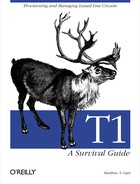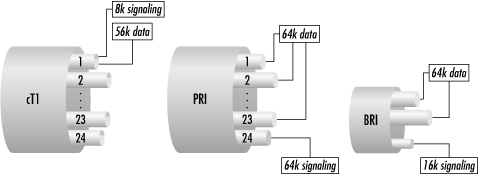The Integrated Services Digital Network, or ISDN, simply extends digital telephone service all the way to the customer. Instead of analog drops from the CO to the customer, it is a complete digital path.
At a high level, ISDN is a composite pipe with subchannels. Subchannels come in two types. Bearer channels, or B channels, are 64-kbps channels that move user data. User data might be a telephone conversation that is digitized at 64 kbps, videoconferencing, or Internet access. B channels are 64-kbps raw digital pipes that can be directed over the telephone network. To connect bearer channels to endpoints across the telephone network, a second subchannel type, called the D channel, provides signaling information. The D channel carries call setup and teardown messages.
ISDN comes in two flavors. Basic rate service is composed of two bearer channels plus a 16-kbps D channel. This package, also known as the ISDN Basic Rate Interface (BRI), is called 2B+D. It provides 128 kbps of user bandwidth in two 64-kbps increments. Each B channel can be used for a digitized telephone call or a raw data pipe. ISDN BRI can be used as two telephone lines, a telephone line plus a 64-kbps data pipe, or a 128-kbps data pipe with no telephone access. Part of ISDN’s appeal is its flexibility. It establishes data calls as circuits through the telephone network, so the division between data and telephony can be dynamic. You may start a large download and fire up both B channels for Internet access. However, if you pick up the phone, one of the two will be disconnected so that the B channel can be reallocated for your impending telephone call.
BRI is an excellent tool for remote locations with relatively small connectivity needs. Many institutions need higher line densities. These demanding customers turn to primary rate ISDN service, which is delivered over a T1 line in the U.S. The Primary Rate Interface (PRI) provides 24 raw 64-kbps channels, each of which corresponds to a T1 time slot. Primary rate ISDN can be provided only over B8ZS lines because only B8ZS can guarantee 64-kbps clear channels. Usually, these channels are provided in a 23B+D configuration. Figure A-15 contrasts cT1 and ISDN PRI.
As it turns out, 64 kbps is a huge amount of bandwidth for signaling, especially considering that dial-in users tend to stay connected for long periods of time. ISDN specifications have been developed to allow a D channel to be shared among several PRIs, a configuration called Network Facilities Associated Signaling (NFAS).
ISDN specifications cover signaling in great detail. While the signaling standards are voluminous and intimidating, the advantage to network administrators is that they are far more uniform than those of cT1.
Q.921 specifies the Link Access Procedure, D Channel (LAPD), which is the data-link layer for ISDN signaling. Q.921 is responsible for framing and basic integrity checking of signaling messages. Within the LAPD frames, messages specified in the Q.930 and Q.931 carry setup information to initiate and end bearer channel connections. No special configuration or additional protocols are needed to perform calling line identification or to determine the called number because all that data is carried in the ISDN call-setup message on the D channel. Using a signaling channel separately from the data-transmission channels is called common-channel signaling (CCS). In the ISDN’s case, the common signaling channel is the D channel.
Devoting an entire 64-kbps time slot to the D channel provides far more signaling bandwidth than is necessary for 23 bearer channels, especially for long-lived Internet access calls. To allow better use of the available bandwidth, multiple PRIs can share D channels. One PRI line in a group is configured in the traditional 23B+D configuration, while secondary lines are configured as 24B, with signaling on the D channel carrier. If the D channel carrier fails, no connections are possible, because the D channel carries setup and disconnection messages. To prevent a group of lines that share a single D channel from becoming inoperative due to the failure of the D channel carrier, ISDN allows a second line in a group to be designated as the backup D channel carrier. Each line in a group of PRIs must be either the primary D channel carrier, the backup D channel carrier, or a secondary data-only line. Configuration of line type is performed jointly by you and the telco, so make sure that your equipment configuration matches the telco’s setup.
To provide all the additional features beyond the simple dialing of plain vanilla telephone service, ISDN signaling is integrated far more deeply with the CO switches. Naturally, the telco is not likely to change the CO switch just for you, so make sure the equipment you purchase will be compatible with the CO switch. In many parts of the country, CO switches support Telcordia’s national ISDN-2 (NI-2) specification for PRIs. If national ISDN features are not available, most equipment provides the ability to interface with the custom ISDN protocols available on the switch model to which you are connecting. In the U.S., the CO switches are commonly the Lucent (AT&T) 5ESS and the Nortel DMS-100, though AT&T 4ESS switches are still in use in many areas.
One oddity of ISDN signaling is that most equipment requests only 56k trunks outside the local exchange. Within a CO, bearer channel connections are 64k, but inter-CO trunks are given only 56 kbps by default. Depending on the telco, you may need to request 64-kbps interoffice trunk channels at the time the line is installed. Some telcos may allow equipment to request 64-kbps channels by dialing the full 10-digit number.
Ordering ISDN is much simpler than ordering cT1 because ISDN has built in so many of the features that users must evaluate and choose between on cT1. Lines must be B8ZS to provide the 64-kbps clear channels, and B8ZS equipment always uses ESF.
Like cT1, primary rate ISDN lines are assigned telephone numbers. Most data-oriented deployments use only one number to create a dial-in pool. ISDN specifications define a Service Profile Identifier (SPID) that allows switches to treat different bearer channels in different ways. Dial-in services are homogenous, so SPIDs are not used—the first available channel picks up an incoming call. Depending on the telco, you may be allowed to specify the order in which channels are used for incoming calls. It will either be ascending, where the lowest available channel picks up, or descending, where the highest available channel answers.
The major unknown for configuring ISDN signaling is the switch type. Indeed, for standalone PRIs, the switch type is the only configuration variable. Service providers using multiple PRIs need to configure shared D channels.
Glare occurs on ISDN circuits when both the CO switch and the customer equipment attempt to use the D channel or one of the B channels. Dial-in services can configure equipment to yield to the CO’s wishes.
In the last section of Chapter 7, there is a list of parameters that network administrators should know about each T1 in their networks. ISDN PRI circuits require additional parameters. For completeness, here is a full list of the parameters that should be maintained on each of the PRI circuits in your network:
Telco circuit number and support contact information
For lines provided in partnership with a service provider other than the telco, a customer number and support contact information
For completeness, note the line code as B8ZS and the framing as ESF
Line speed (channel speed and number of DS0s)
Line build out information
Transmit clocking and DTE clocking settings, along with the make and model of the DTE
Whether the PRI is one way (dial-in only) or two way (dial-in and dial-out)
Assigned telephone number
Channel sequencing (ascending or descending)
Channel configuration (23B+D or 24B with NFAS)
NFAS-related configuration (if the line carries a D channel, whether it is the primary or secondary carrier; if not, then it must be associated with the D channel on another line)
Switch type (NI-2, 4ESS, 5ESS, or DMS-100)
Interoffice trunk speed selection
The following must be configured when using ISDN PRI:
- Switch type
ISDN PRI interfaces are direct digital interfaces to the telephone switch. Customer equipment must match the feature set deployed at the central office. Most likely, it will be for some variety of national.[27] In some spots, though, it could be for an AT&T 4ESS, 5ESS, or Nortel DMS-100.
- D channels
Not all PRIs are 23B+D. D channels may be used to support signaling for multiple PRIs using NFAS. PRIs with D channels in an NFAS configuration may be either the primary D channel or a backup D channel and must be configured appropriately. PRIs without D channels must be associated with a D channel-carrying PRI.
[27] Several “national” ISDN (NI) specifications exist. NI-1 is the current BRI specification, and NI-2 is the current PRI specification. Equipment vendors have realized the folly in referring to the exact specification—there is no reason to change the term simply because an additional specification has added functionality. In preparation for the day when equipment might implement several national ISDN specifications, most vendors have changed the designation to simply national.

